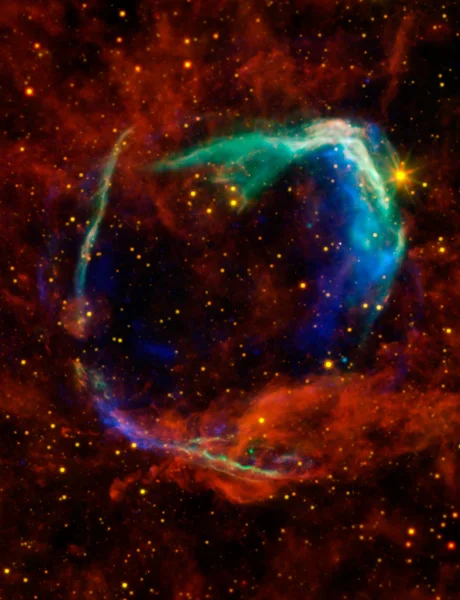A picture of the remnants of the first ever documented supernova in unprecedented detail

A new image, taken by a camera designed to study dark matter, has revealed the remnants of the first ever documented supernova in unprecedented detail.
The image, taken by the US Department of Energy's Dark Energy Camera on the Víctor M. Blanco telescope of the NOIRLab program of the National Science Foundation (NSF) in Chile, shows sparse, tendrils-like clouds of dust and gas scattering around the supernova's central point. .
These shredded pieces encircle an area larger than the apparent size of the full moon between the constellations Circinus and Centaurus in the southern sky.
The strange cloud, known to astronomers as RCW 86, is believed to be all that remains of a white dwarf star that exploded more than 1,800 years ago with such ferocity that it caught the attention of ancient Chinese astronomers and historians.
The supernova was called a "guest star" by the ancient Chinese because of its temporary nature. The supernova, known today officially as SN 185, was spotted in the year 185 and was visible to the naked eye for eight months before fading from view.
Astronomers now know that the event occurred 8,000 light-years away in the direction of the sun's nearest stellar sibling, the triple star Alpha Centauri.
Thanks to its ability to see a large part of the sky at the same time without compromising the level of detail, the Dark Energy Camera (DECam) provided astronomers with "a rare view of the entire supernova remnant as we see it today," according to the NOIRLab program statement, which published the image on Wednesday, March 1.
Astronomers hope that this new, deeper look at the resulting object, RCW 86, will help them better uncover the puzzling physics that led to the long-ago explosion.
And while astronomers today agree that RCW 86 is a remnant from supernova SN 185, that wasn't always the case. Scientists have long believed that the size of the cloud-like structure was too large to be produced in that explosion.
Calculations from previous studies estimated that it would take 10,000 years for material to disperse away from the dead star, and this would make the structure much older than the supernova observed in the year 185.

And in 2006, astronomers found evidence that the cloud's large size was due to an extremely high velocity of expansion, at a much faster rate than they originally thought.
Finally, observations by NASA's Spitzer Space Telescope revealed large amounts of iron in the material, leading astronomers to conclude that the explosion that produced RCW 86 must be the most active type of supernova known, a type Ia.
This type occurs in a binary star system when a dense white dwarf (the dense remnant of a sun-like star) siphons material from its orbiting companion to the point of explosion.
These types of supernovae produce so much light that this phenomenon did not go unnoticed even in the distant past when astronomers limited their observations to the naked eye.
"These supernovae are the brightest ever recorded, and there is no doubt that SN 185 would have spooked observers as it shone brightly in the night sky," the scientists wrote in the statement.
Astronomers now have a more complete picture of how RCW 86 formed. When the binary system's white dwarf swallowed the material of its companion star, its high-speed winds pushed the surrounding gas and dust outward, creating the cavity we observe today. Then, when the white dwarf could not bear any mass falling on it from the companion star, it exploded in a violent explosion.
The pre-formed cavity gave plenty of space for the remnants of high-velocity stars to expand very quickly and to create the massive features we see today.
Source : Websites

